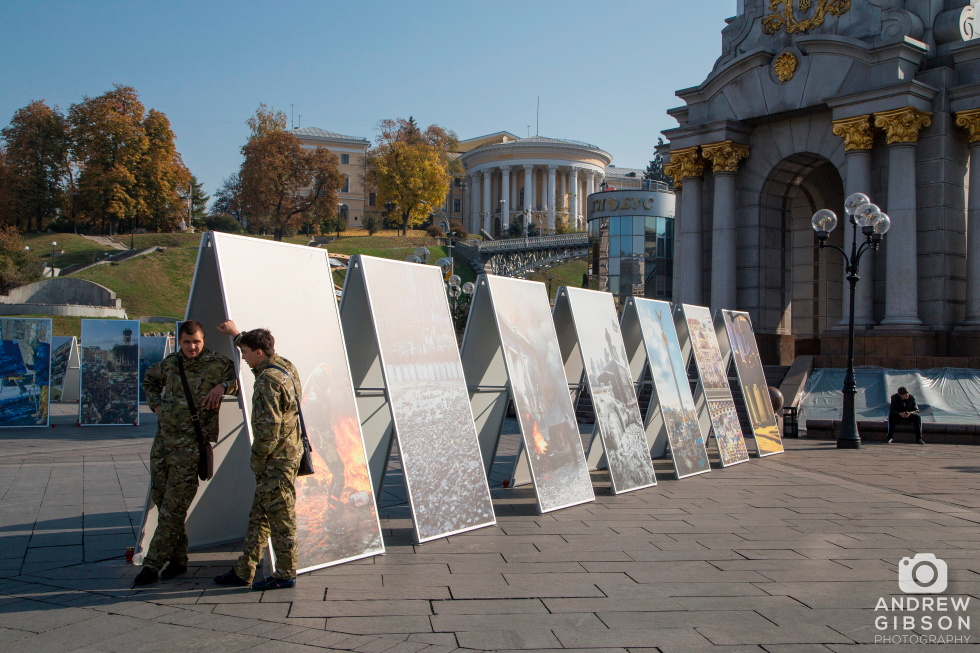As soon as I stepped off the plane the warm air hit me. I was back in Kyiv, and it felt good. “Hot, tomorrow” said the taxi driver in extremely broken English, “twenty degrees” as he tried to engage in conversation with me. It was good news – I was here to revisit the Chernobyl exclusion zone and the prospect of blue skies and autumn sunshine was exactly what I was looking for photographically.
I first visited this jewel in the crown of Eastern Europe 18 months ago and instantly fell in love with it. Culturally rich and diverse with fine architecture everywhere you looked; it was never a question of whether I would return rather the matter of when.
But the past 18 months have been turbulent ones for Ukraine. This time last year deep resentment against the pro-Russian President and his leadership was fast rising to the surface and I watched with fascination as peaceful protest turned into street fighting and conflict that would scar Independence Square and radiate outwards. News coverage in the west was sketchy at first, almost ambivalent towards the plight of Kyiv and its people. Hordes of people gathered in the centre as an impasse developed between the authorities and the residents’ rising appetite for the overthrowing of their corrupt government. Ultimately blood would be shed and fires would burn, the monolithic Lenin statue at the head of Shevchenko Boulevard toppled and smashed to the sounds of a jubilant crowd. By February political prisoner and former Prime Minister Yulia Tymoshenko would be released from jail as the reviled President Yanukovych fled to Russia. It all seemed like the end was in sight – but it was only the beginning.
Back in the present I took in the sights of central Kyiv as evening fell. It looked the same from a distance but up close the paving was damaged, the granite steps chipped, the trade union building under reconstruction after being burnt out. Yet there was warmth here, positivity in the face of great adversity. Kyiv was down – but it certainly wasn’t out.
Today, Independence Square remembers the turmoil depicted on sandwich boards radiating out from its iconic monument. Candles are lit for the dead and tributes are evident everywhere. The country is desperate for tourist revenues, its people happy to talk, but it’s not painting over the cracks and trying to hide its troubles – it has them on display for all to see. They want the world to understand what has happened, and that they are fighting for their independence once more.
Blue and yellow graffiti adorns monuments, the flag flies proudly throughout, and even the grand pedestrian bridge over the river is lit up in the national colours. Lenin’s plinth – minus his statue – is daubed with paint and covered in fly posters, while Shevchenko Boulevard’s paving is painted with messages. Some talk of the futility of war, written in the Russian language and demonstrating that even Kyiv’s Russian speakers are on the side of their city. The message couldn’t be clearer – we are Ukrainian, and that’s the way it’s staying.
But they’re tired too. “We asked for help, but nobody comes” was what one lady had to say about a wider world cautiously minding their business interests and their energy supplies. It’s a universal concern here as well though: Down on the markets Soviet memorabilia is big business. I asked some of the traders if it was considered insensitive given the current situation. The authorities had asked them to stop – but they know their markets, and what the tourists are interested in. The edge is taken off with the prominent anti-Putin memorabilia though and you can even buy toilet rolls with his face on every sheet.
Kyiv in 2014 is as beautiful as ever, its rich history embellished by its recent troubles that make visiting all the more fascinating and poignant. Almost as soon as I’d arrived I was leaving. It wasn’t nearly long enough. It never is…

